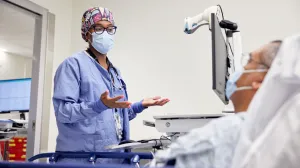
Peter Slovenski woke up with a “lightning bolt” of pain in his upper lip. Unlike his recurring tooth pain, which would come and go, the pain in his lip was agonizing and didn’t dissipate.
“It was something I couldn’t live with,” he said. “It was an excruciating pain that stayed with me from that morning on.”
Looking for answers, Slovenski Googled “profound or extremely sharp pain in the upper lip” and up popped trigeminal neuralgia, a nerve disorder that affects the trigeminal nerve in the face. The disorder causes sudden, electric shock-like pain in the upper lip and can be triggered by something as light as the wind on your face, chewing, drinking, brushing your teeth, shaving or putting on makeup.
Trigeminal neuralgia is often caused by the compression of the trigeminal nerve, which is in charge of receiving sensation to the face. The compression is often caused by blood vessels, but it can also be caused by multiple sclerosis, tumors or facial trauma. However, many cases there is no obvious cause.
Coincidentally, Slovenski had a doctor’s appointment on the same day as he was having a trigeminal neuralgia attack in his upper lip that was so intense he was unable to speak. His doctor immediately wrote him a prescription for gabapentin, a medication that relieves pain for nervous system conditions. Forty minutes after taking the medication, the pain subsided, and he was able to talk again.
Unfortunately, Slovenski said that over time, the effectiveness of the medication wears off and the “lightning bolt” pain returns.
“Over time, the nerve problem that is creating the pain figures out how to get past what the medication is doing, and the pain starts to make itself known again,” he said.
Slovenski began taking higher doses of the drug, which worked for a time until side effects like fatigue and memory loss became more noticeable, especially in his job as Bowdoin College’s track coach.
“I normally could have 3 lines of notes and speak for 6 minutes,” he said. “I had to start writing 10 lines of notes to speak for 6 minutes.”
He was put on oxcarbazepine, a drug that prevents seizures that can also be taken for nerve pain caused by trigeminal neuralgia. The medication kept the pain at bay, but some pain came back. Like gabapentin, the medication had side effects that caused Slovenski to be fatigued and his memory to be taxed. After trying two different medications with no cure in sight, his neurologist said, “I think it’s time for you to go to Boston and see Dr. Wu.”
His neurologist knew there were treatments outside of medication that could relieve the pain he was experiencing.
That’s when Slovenski learned from Dr. Julian Wu, co-director of Gamma Knife radiosurgery at Tufts Medical Center, that he was a candidate for the procedure. Gamma Knife uses tiny beams of radiation to target the trigeminal nerve, which carries pain signals from the face. It was a less invasive option compared to brain surgery, which carries higher risks, Slovenski said.
“The radiation seemed to be a brilliant alternative to gain many more years of pain-free life,” he said.
After Slovenski had an MRI of his head taken to help aim the radiation to the precise spot in his trigeminal nerve, it was time for the Gamma Knife. Patients wear a special helmet-like device that precisely focuses radiation beams on the target.
The procedure took about 20 minutes of Slovenski lying completely still while radiation was delivered to his trigeminal nerve.
“When I finished, I was hopeful, but I was trying not to get my hopes up,” he said. “I was trying not to have my hopes rise too high.”
The next day, he was back at track practice and work. Over the next 6 weeks, Dr. Wu and his neurologist would reduce the medication dosage he was on until he was completely off medication.
“I was pain-free and it was miraculous,” he said. “I had no pain, and it was a fabulous feeling to be off meds for the first time in 3 years.”
To think that Slovenski had come this far with incredible shooting pain so debilitating that he couldn’t talk or eat, to being off medication totally was unfathomable. Not everyone gets relief from radiation, and the amount of time it lasts can vary. In general, the average number of pain-free years post-surgery is 5 years, he said.
Now 69, Slovenski has had 6 pain-free years since the surgery and credits Dr. Wu, whom he wrote to 2 years post-surgery and again at 5 years.
“I wanted him to know I made it past five years because of the skill he had in using radiation to both change the trigeminal nerve so I wasn’t getting trigeminal neuralgia face pain, but not to change it so much that I had any of the other ill effects,” Slovenski said.
Trigeminal neuralgia nearly pushed him to retire at 63 or 64, but thanks to Gamma Knife, he was able to work for 34 years until he was 65, which was an important milestone for him to reach.
It was a wonderful experience to be guided through the options by Dr. Wu with a condition that was very resistant to certain outcomes or guarantees of treatment outcomes. My outcomes were remarkably positive.
Peter Slovenski, patient
At 66, Slovenski and his wife moved to Tennessee to be closer to his son and his family. Slovenski spends his days helping his son run a 90-acre farm, babysitting and homeschooling his grandchildren.
And, each May, he moves back to Maine and runs a summer camp started by his 3 sons.
“I feel great,” he said. “Every day I wake up feeling grateful. Ninety-nine percent of the days of the year, I wake up feeling healthy. All 365 days of the year, I don’t feel any of the pain of trigeminal neuralgia.”


